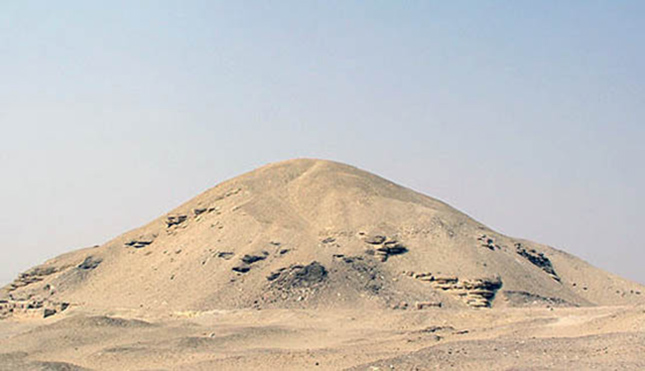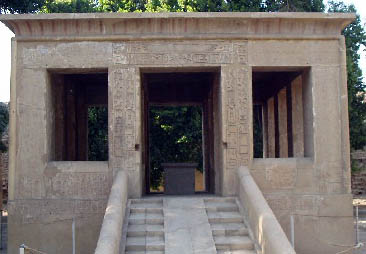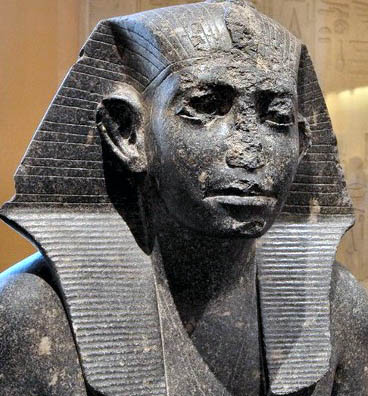ELEVENTH DYNASTY
The first ruler of the Eleventh dynasty was Antef (also Intef) of Thebe. The seat of the dynasty was in fact Hermonthis in contrary to Thebes that at that time just started to develop as a town settlement. Although dynasty began earlier, Middle Kingdom started with his successor Mentuhotep I.
Mentuhotep I (Nebhepetre) (1992. – 1985.)
After the war, Mentuhotep reunites Egypt, but at the time of the Eleventh Dynasty, a country was still unstable. The power is expanding and in Nubia, while in the Delta penetrated Libyans and Asians. Thebes grew into one of the capitals of the restored kingdom. Here Mentuhotep build to himself a posthumous temple. He often changed its name so Egyptologists had an impression that there were more rulers, but further investigations led to the conclusion that it was however one person. His act of union for the Egyptians was a historic event and it was importance as the legendary union of the King Menes (Narmer).
Statue of Mentuhotep was found by Howard Carter in a Bab el Hosan. It was probably made in order to celebrate the King’s jubilee heb-sed. This means a celebration of the thirtieth reign, and it was later called the king’s jubilee.
Mentuhotep II Sankhare
From his period, are important documents of the Hekanakha letters (Pharaoh’s vizier and priest) to his son Ipi. These documents show that the country was ruled by the hunger and poverty.
Mentuhotep III Nebtauire
For unknown reasons, he was left out of the king’s list, but he was mentioned in the Turin Canon. In his time vizier, Amenemhat organized a tour of the mine. At that time, he was a governor of Upper Egypt and he was mentioned as a co-ruler of the Pharaoh. He will be the founder of a new dynasty.
Mentuhotep IV
Mentuhotep V
Mentuhotep VI
He manages to beat the Asians that at the beginning of the dynasty broke into the Delta.
TWELFTH DYNASTY (1.985 – 1.773)
Amenemhat I (1.985 – 1.956)



He moved to the capital from Thebes on the north to Lisht (Iz-taui) which was near the entrance to the Faiyum. This move was necessary in order to move the central government closer to the Delta, which needed constantly to be defended from various attacks from the north. He tried to strengthen the political and moral position of the kingdom, which with the collapse of the Old country lost its power.
He tried to regulate a state government so that it provides him with an accurate view of the economic situation and enables him a control of the provinces. He tightened the power of some nomarchs, he also limited their nomes by determining exactly which channels belong to them and for which parts of the Nile coast they need to worry.
Besides that, he led the military campaigns in Palestine and Nubia. There were indications that he took power by force because he was a vizier in the period of Mentuhotep IV., in this position he strengthened and eventually took power from a weaker ruler.
Therefore, he was announced in the Nefertiti prophecy: ‘the king from the south named Ameni will come…He will get hold of the white crown, he will wear a red crown … a son of an ordinary man will make his name eternal.’ It was believed that this prophecy was written in the age of Sneferu, but today it turned out that it was written in the Middle Kingdom. This prophecy was considered some kind of Amenemhat political propaganda, which Amenemhat needed to legitimize his authority. He was killed in the palace conspiracy (eunuchs).
The Instruction of Amenemhet; a very well known literary work of that period in which already dead Amenemhat teaches Sesostris of the prudent and proper manners of how to rule by coming into his dreams.
Sesostris I (Sanusret I) (1.956 – 1.911)



Son of Amenemhat I, who set him on the throne, at the age of twenty, to be a co-ruler with his father probably because from the fear of overturn. In the eighteenth year of his reign, Egyptians have established strongholds in the south, between the first and second cataract of the river Nile, also they established a trading colony in Kerma where it was discovered a combination of Egyptian and Nubian culture.
In Karnak was discovered his chapel. The chapel was taken apart, restored, and reassembled. Fayum province by irrigation has become fertile land and soon that area near Memphis has become one of the richest regions of Egypt.
Amenemhat II (1.911 – 1.877)
He had good trade relations with Mesopotamia where it was found a statue of his daughter. During his reign it has been recorded an increased immigration of Semites in Egypt.
Sesostris II (Sanusret II) (1.877 – 1.870)
Sesostris III (Sanusret III) (1.870 – 1.831)
He was remembered as a powerful warrior ruler who finally broke the resistance of the local aristocracy and established a stable central government and, under his rule, Middle Kingdom, achieved its peak. During his time, a construction of monumental tombs for nobles was stopped, and all the nomarsh land was taken away from them while governors are again just clerks.



The land is in the hands of the state and farmers receive it in order to use it for personal purposes but they have to give one part of the product to the ruler.
The population is also obliged to perform other tasks such as public works, etc., but this time they are not obliged by the ruler or nomarch but they are free people. He fought with desert tribes in the north, and after that, he headed to the south, in Nubia.
For the purpose of that war, he built a canal at the I. cataract, which he used for the transport of its troops. After the war, he raised fortitudes next to II. cataract, on the each side of the Nile. During Tuthmosis I reign, he was declared a divine on the area between I. and II. cataracts. At that, time wars in the Syria were fought, while the Phoenicians recognized Egyptian power also.
Ruler solved an unstable situation by military interventions and by removing the preconditions for the life of rebellious inhabitants. By destroying villages, stocks of grain and all assets of the local population, people who were reluctant to Egypt in the end were incapacitated for threatening of the Egyptian borders.
In Egypt defensive walls were built (since of Amenemhat I time) on which Sesostris sets its sculptures. He organized the national authorities, councils Uaret and Djadjat. There has been a record of Sotis’s appearance during seventh year of an emergence of SOTIS (Sirius star) the seventh year of Sesostris reign.
Amenemhat III (1.831 – 1.786.)
Amenemhat IV (1.786 – 1.777)
Egyptian authority in Nubia has strengthened, while Egyptians were using more and Sinai mines.
Queen Sobeknofer (1.777 – 1.773)
The last ruler of the twelfth dynasty was Amenemhat III. daughter and Amenemhat IV. sister. After her came large crisis in the country. Semitic (Hyksos) people immigrated to the Delta; those are the same Hyksos, which later took over authority in Egypt.
